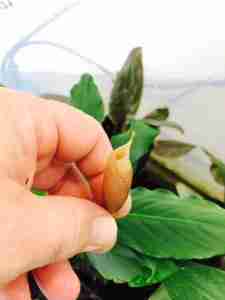 I ordered some plants and as an extra special surprise of unknown certainty I obtained some plants without knowing what I was to get. Usually I like to know what I’m getting, or at least how to take care of it. There was one plant wrapped in a paper towel bare rooted and stuffed into a grip of moist long fiber sphagnum moss. I looked at it and at first though it was a homolomena or similar aroid. The paper tucked inside the paper towel said Ooia graboskii (I’m not really certain it is as it is not readily available or distributed).
I ordered some plants and as an extra special surprise of unknown certainty I obtained some plants without knowing what I was to get. Usually I like to know what I’m getting, or at least how to take care of it. There was one plant wrapped in a paper towel bare rooted and stuffed into a grip of moist long fiber sphagnum moss. I looked at it and at first though it was a homolomena or similar aroid. The paper tucked inside the paper towel said Ooia graboskii (I’m not really certain it is as it is not readily available or distributed).
I had honestly never heard nor seen ooia grabowskii until now. I knew little or nothing about it other than it was an aroid. It looked obviously like an aroid, the likes of bucephalandra, piptospatha, and cryptocorynes but different. I had absolutely no idea of its growing requirements, lighting, or fertilization needs. I was in the dark.
A quick internet search led me to almost no where. The only images that I could readily find were of the wonderful adventures of the venerable and often fascinating expeditions of Michael Lo in his blog Jungle Mikes Secret Gardens. It did give me some wonderful insight into its growing habits and habitat.
Turns out that it was a rheophyte from its growing pictures (well of the ooia in general). If it was a rheophyte it must live submerged in fast water at least part of its life. I potted the plant up in a 3 inch pot with 1 part sand, 1 part fine gravel 3mm particles, 1 part potting mix and 1 part fired clay. I set it in a growing tub with about 2 inches of water and provided it with 2 t8 fluorescent bulbs for lighting. The clear cover of the tub was put on loosely to maintain as high a level of humidity as I could provide. To start with I sprayed it with an atomizer several times a day. Over time I worked down to almost never spraying it aside rfom when I inspect it or to cut off shoots to grow elsewhere.
After digging around a little more I found that Mr. Peter Boyce, a well known botanist, had written a paper about some ooia so I read that. At least I was headed in the right direction as best I could tell. One day I decided to take a picture of my plant and post it on the International Aroid Society’s facebook page. Mr. Boyce confirmed that it was apparently ooia but what ooia was still unknown exactly.
At the moment the ooia is fruiting and I will soon remove the inflorescence and dissect it. The fruit needs more than one single plant to contribute to making seed anyway so it is a dead end for the spathe nonetheless. Once it is opened and examined perhaps I will be able to accurately tell what exactly this plant is (or shall I say someone that knows their plants much better than I). I’m interested to find out and have been waiting for months to find out exactly what it is. So far it has been growing very well for me and Id like to plant some submersed to see what it grows like or if it will thrive in an aquarium.
— I have sliced open the inflorescence and it was established by Mr. Peter Boyce that it was an ooia. However the stage of being able to tell had just passed and it was not a clean specimen to tell what exactly the ooia was. I hope that it will again produce so that it can be established what it is.
 Biotope One A Study of Flora and Fauna
Biotope One A Study of Flora and Fauna 


